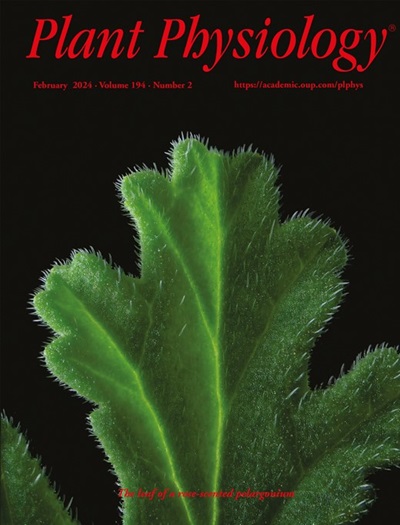Major Facilitator Superfamily (MFS) transporters balance sugar metabolism in peach.
IF 6.5
1区 生物学
Q1 PLANT SCIENCES
引用次数: 0
Abstract
Sugar content is a key determinant of peach (Prunus persica) fruit quality, influencing taste, consumer preferences, and market value. However, the roles of Major Facilitator Superfamily (MFS) transporters in sugar metabolism and regulation remain largely unexplored. This study employed a combination of spatial metabolomics, quantitative genetics, transcriptomics, comparative genomics, and functional genomics to investigate the role of 67 MFS members in balancing sugar metabolism during peach fruit development. Spatial metabolomics revealed dynamic sugar distribution patterns, with ERD6-like transporters (PpERDL16-1) and tonoplastic sugar transporters 1 (PpTST1) promoting sucrose accumulation and Polyol/monosaccharide transporters 5 (PpPMT5-1) and sucrose transporters 4 (PpSUT4) reducing sucrose transport during fruit ripening. Functional studies confirmed these roles: PpERDL16-1 overexpression enhanced sucrose transport, and PpPMT5-1 or PpSUT4 silencing reduced sugar levels in peach fruit. Quantitative trait locus (QTL) mapping identified a major locus on chromosome 5, upstream of PpTST1, forming distinct haplotypes (Hap1 and Hap2). Hap1 was associated with lower PpTST1 expression and higher sugar and soluble solids content (SSC), while Hap2 was linked to higher PpTST1 expression and lower sugar content. This inverse relationship suggests that upstream genetic variants fine-tune PpTST1 expression in a context-dependent manner, potentially through interactions with transcription factors or epigenetic modifiers. Notably, PpTST1 overexpression increased sugar content but did not alter SSC, indicating compensatory mechanisms such as changes in organic acid metabolism or water content. These results illuminate the molecular mechanisms regulating sugar homeostasis in peach fruits, providing valuable targets for the genetic improvement of fruit quality through breeding programs.主要促进转运体超家族(MFS)平衡桃糖代谢。
含糖量是桃子果实品质的关键决定因素,影响口感、消费者偏好和市场价值。然而,主要促进者超家族(MFS)转运体在糖代谢和调节中的作用在很大程度上仍未被探索。本研究采用空间代谢组学、数量遗传学、转录组学、比较基因组学和功能基因组学相结合的方法,研究了67个MFS成员在桃果实发育过程中糖代谢平衡中的作用。空间代谢组学揭示了糖的动态分布模式,在果实成熟过程中,erd6样转运蛋白(PpERDL16-1)和tonoplastic糖转运蛋白1 (PpTST1)促进蔗糖积累,而多元醇/单糖转运蛋白5 (PpPMT5-1)和蔗糖转运蛋白4 (PpSUT4)减少蔗糖转运。功能研究证实了这些作用:ppperdl16 -1过表达增强了蔗糖转运,PpPMT5-1或PpSUT4沉默降低了桃子果实中的糖水平。定量性状位点(QTL)定位在PpTST1上游的5号染色体上,形成了不同的单倍型(Hap1和Hap2)。Hap1与PpTST1低表达、高糖和可溶性固形物含量(SSC)相关,而Hap2与PpTST1高表达、低糖含量相关。这种反向关系表明,上游遗传变异可能通过与转录因子或表观遗传修饰因子的相互作用,以上下文依赖的方式微调PpTST1的表达。值得注意的是,PpTST1过表达增加了糖含量,但没有改变SSC,这表明有机酸代谢或水分含量的变化等代偿机制。这些结果阐明了桃果实糖稳态调控的分子机制,为桃果实品质遗传改良提供了有价值的靶点。
本文章由计算机程序翻译,如有差异,请以英文原文为准。
求助全文
约1分钟内获得全文
求助全文
来源期刊

Plant Physiology
生物-植物科学
CiteScore
12.20
自引率
5.40%
发文量
535
审稿时长
2.3 months
期刊介绍:
Plant Physiology® is a distinguished and highly respected journal with a rich history dating back to its establishment in 1926. It stands as a leading international publication in the field of plant biology, covering a comprehensive range of topics from the molecular and structural aspects of plant life to systems biology and ecophysiology. Recognized as the most highly cited journal in plant sciences, Plant Physiology® is a testament to its commitment to excellence and the dissemination of groundbreaking research.
As the official publication of the American Society of Plant Biologists, Plant Physiology® upholds rigorous peer-review standards, ensuring that the scientific community receives the highest quality research. The journal releases 12 issues annually, providing a steady stream of new findings and insights to its readership.
 求助内容:
求助内容: 应助结果提醒方式:
应助结果提醒方式:


